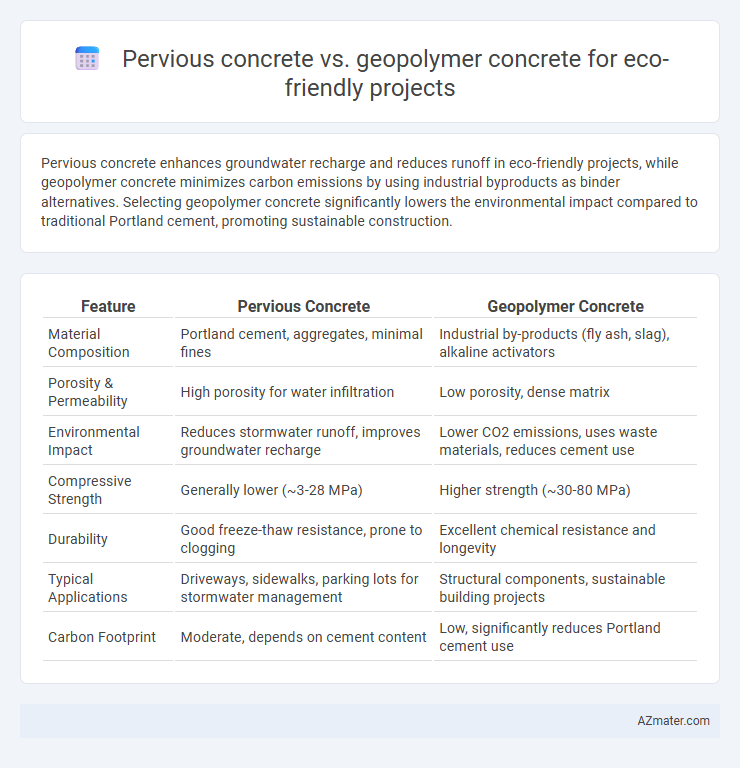Pervious concrete enhances groundwater recharge and reduces runoff in eco-friendly projects, while geopolymer concrete minimizes carbon emissions by using industrial byproducts as binder alternatives. Selecting geopolymer concrete significantly lowers the environmental impact compared to traditional Portland cement, promoting sustainable construction.
Table of Comparison
| Feature | Pervious Concrete | Geopolymer Concrete |
|---|---|---|
| Material Composition | Portland cement, aggregates, minimal fines | Industrial by-products (fly ash, slag), alkaline activators |
| Porosity & Permeability | High porosity for water infiltration | Low porosity, dense matrix |
| Environmental Impact | Reduces stormwater runoff, improves groundwater recharge | Lower CO2 emissions, uses waste materials, reduces cement use |
| Compressive Strength | Generally lower (~3-28 MPa) | Higher strength (~30-80 MPa) |
| Durability | Good freeze-thaw resistance, prone to clogging | Excellent chemical resistance and longevity |
| Typical Applications | Driveways, sidewalks, parking lots for stormwater management | Structural components, sustainable building projects |
| Carbon Footprint | Moderate, depends on cement content | Low, significantly reduces Portland cement use |
Introduction to Eco-Friendly Concrete Solutions
Pervious concrete and geopolymer concrete are innovative eco-friendly solutions that reduce environmental impact in construction by enhancing sustainability and minimizing carbon footprints. Pervious concrete promotes stormwater management and groundwater recharge through its high porosity, while geopolymer concrete utilizes industrial byproducts like fly ash or slag, significantly lowering CO2 emissions compared to traditional Portland cement. Both materials offer durable and sustainable alternatives that support green building initiatives and comply with environmental regulations.
Understanding Pervious Concrete: Key Features
Pervious concrete is a highly permeable material consisting of cement, coarse aggregates, and water, designed to allow water to pass through and reduce runoff, making it ideal for eco-friendly projects focused on stormwater management. Its key features include high porosity, which supports groundwater recharge and mitigates urban flooding, and reduced heat island effect due to its open-graded structure. Unlike geopolymer concrete, pervious concrete primarily emphasizes permeability and sustainable water management, contributing significantly to environmental conservation efforts.
Geopolymer Concrete Explained
Geopolymer concrete is an eco-friendly alternative to traditional cement-based materials, utilizing industrial byproducts like fly ash and slag to significantly reduce carbon emissions during production. Its chemical composition forms strong, durable bonds through geopolymerization, offering enhanced resistance to fire, chemicals, and freeze-thaw cycles compared to pervious concrete. This sustainable material supports green construction projects by lowering environmental impact while maintaining structural integrity and permeability benefits similar to pervious concrete.
Environmental Impacts: Pervious vs Geopolymer Concrete
Pervious concrete significantly reduces stormwater runoff and promotes groundwater recharge, lowering urban flooding risks and mitigating heat island effects. Geopolymer concrete offers a substantially lower carbon footprint by utilizing industrial byproducts like fly ash, cutting CO2 emissions by up to 80% compared to traditional Portland cement. Both materials support sustainable construction, but geopolymer concrete provides greater reduction in greenhouse gases, while pervious concrete excels in improving water management and reducing environmental pollution.
Raw Materials and Sustainability Factors
Pervious concrete primarily utilizes conventional Portland cement, aggregates, and water, offering high permeability for stormwater management while supporting groundwater recharge, thus enhancing urban sustainability. Geopolymer concrete leverages industrial by-products like fly ash or slag activated with alkaline solutions, significantly reducing carbon emissions by avoiding traditional cement production. Both materials contribute to eco-friendly construction, with pervious concrete excelling in water conservation and geopolymer concrete advancing circular economy principles through waste material reuse.
Performance Comparison: Strength and Durability
Pervious concrete offers high permeability and moderate compressive strength, typically ranging between 10 to 30 MPa, making it ideal for sustainable drainage systems but less suitable for heavy load-bearing structures. Geopolymer concrete demonstrates superior mechanical strength, often exceeding 40 MPa, coupled with enhanced chemical resistance and durability under aggressive environmental conditions, ideal for eco-friendly infrastructure with extended service life. The durability of geopolymer concrete surpasses traditional pervious concrete by exhibiting better resistance to sulfate attack, freeze-thaw cycles, and reduced permeability, ensuring long-term performance in sustainable construction projects.
Permeability and Water Management Benefits
Pervious concrete offers superior permeability, enabling efficient stormwater infiltration and reducing surface runoff, which significantly benefits urban water management and groundwater recharge. Geopolymer concrete, while less permeable, provides enhanced durability and chemical resistance, making it ideal for eco-friendly projects requiring reduced environmental impact through sustainable material use. Both materials contribute to eco-friendly water management but prioritize different ecological functions: pervious concrete excels in permeability and water filtration, whereas geopolymer concrete focuses on sustainability and long-term resilience.
Carbon Footprint and Energy Consumption
Pervious concrete significantly reduces carbon footprint by allowing stormwater infiltration, minimizing runoff, and requiring less cement compared to traditional mixes, which lowers CO2 emissions. Geopolymer concrete offers superior energy efficiency by utilizing industrial waste materials like fly ash and slag, drastically cutting down reliance on energy-intensive Portland cement production. Both materials provide sustainable options, yet geopolymer concrete leads in lowering overall carbon emissions and energy consumption for eco-friendly construction projects.
Cost Analysis and Project Feasibility
Pervious concrete generally offers lower upfront costs due to its simple mix design and widespread availability of materials, making it suitable for projects prioritizing budget constraints and stormwater management. Geopolymer concrete, while having higher initial expenses from specialized binders like fly ash or slag, provides long-term savings through superior durability and reduced carbon footprint, ideal for sustainable construction goals aligned with eco-friendly certifications. Project feasibility depends on balancing these cost factors with lifecycle environmental benefits, local material accessibility, and specific performance requirements for green infrastructure initiatives.
Choosing the Right Concrete for Eco-Friendly Projects
Pervious concrete enhances groundwater recharge and reduces stormwater runoff, making it ideal for sustainable urban drainage systems in eco-friendly projects. Geopolymer concrete offers exceptional durability and a significantly lower carbon footprint by utilizing industrial byproducts like fly ash and slag as binders. Selecting between these concretes depends on project goals: pervious concrete excels in permeability and water management, while geopolymer concrete prioritizes environmental impact reduction and structural longevity.

Infographic: Pervious concrete vs Geopolymer concrete for Eco-friendly project
 azmater.com
azmater.com